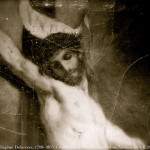We run our website the way we wished the whole internet worked: we provide high quality original content with no ads. We are funded solely by your direct support. Please consider supporting this project.

Redefining Transcendence
God is transcendent, which basically means that God is “other” than creation. The problem is that classical thinking about God’s “otherness” has been limited to what reason can discern about God. As a result, all that can be said about his transcendence is what God is not. We are thus unable to acquire a positive conception of a wholly simple, purely actual, immutable, timeless, limitless, perfect being that exists, not over-and-against the world as a particular deity, but as the cause and “transcendental unity” of all existing things in the world. As such, there is a kind of agnosticism about this view of because we are unable to say anything concrete or positive about who God is.
By relying heavily on the negative approach of Hellenistic philosophy, the classical tradition ended up defining God’s transcendence over-and-against revelation, which is why this tradition assumed the revelation of God in Christ and in Scripture had nothing to say about the nature of God’s transcendent attributes that reason couldn’t discern on its own. It is claimed that revelation is also bound to the finite categories of human thinking and speaking, and therefore “revelation does not tell us what God is.” Instead, it simply “joins us to him as if to an unknown…”[1]
By limiting itself to what reason can discern about what God is not, classical theology failed to explore the even more mysterious, and the much more beautiful, “otherness” of what God reveals himself to be.
I argue that the “otherness” of God is only properly exalted, and God’s self-revelation on the cross is only properly honored, when God’s transcendence is most fundamentally defined by means of what is revealed in the crucified Christ rather than in contrast to what is revealed in the crucified Christ.
Could anything be more incomprehensible and more exalting of God’s mysterious “otherness” than the depth of love that motivated the Son to set aside the bliss of his communion with the Father and Spirit and to dive into the self-created hell of a race of rebels? Could any mere philosophical negation be more mysterious than the God who manifested his greatness by becoming a microscopic zygote in the womb of an unwed Jewish peasant girl? And could there be any greater indicator of the unfathomable nature of God’s transcendence than the fact that God’s holiness was most perfectly displayed when God became our sin (2 Cor 5:21) or the fact that God’s perfect loving unity was most perfectly displayed when God experienced our God-forsakenness (Gal 3:13)?
While God’s transcendence is certainly incomprehensible, I submit that God’s ability and loving willingness to radically change for us — to the point of becoming that which he is not when he hung on the cross — is even more beautifully unfathomable and even more exalting of God’s “otherness.” While God’s eternal character and being are certainly mysterious, I contend that God’s ability and loving willingness to nevertheless be deeply impacted and moved by us, and even to suffer hell on our behalf, is even more beautifully mysterious and exalting of God.
In short, my argument is that the transcendent moral character of God revealed in the crucified Christ and witnessed to in biblical depictions of God being in sequence with us, changing plans in response to us, and being impacted and moved by us, should be regarded as more fundamental to our appreciation of God’s transcendence than the metaphysical transcendence of God that can be discerned by reason.
God becoming human and suffering on the cross do not compromise divine transcendence. To the contrary, depictions of God along these lines reflect the kind of incomprehensibly loving divine transcendence that is revealed in the crucified Christ.
[1] Aquinas, Summa Contra Gentiles, Q 12, art. 13, 136.
Category: General
Tags: Classical Theism, Cruciform Theology, Revelation
Topics: Attributes and Character
Related Reading

Cross Vision Coming Soon!
In Greg’s new book, Cross Vision, he explains how the crucifixion of Jesus makes sense of the violent portraits of God in the Old Testament. His groundbreaking “cruciform hermeneutic” will change the way that you read the Bible! While Crucifixion of the Warrior God laid out Greg’s case in detail for an academic audience, Cross Vision…

Did Yahweh Crush His Son?
Though Isaiah was probably referring to the nation of Israel as Yahweh’s “suffering servant” when these words were penned, the NT authors as well as other early church fathers interpreted this servant to be a prophetic reference to Christ. Speaking proleptically, Isaiah declares that this suffering servant was “punished” and “stricken by God” (Isa 53:4,…

Sermons: The Church – Week Five
In week five of this sermon series, Greg Boyd discusses what the church should look like in the lens of the cross. A universal Church was born out of the ministry of Jesus, and this Church is empowered to look like the Cross. In this sermon, Greg shows us why it’s so important, as the…

Revelation 13:8 refers to “everyone whose names have not been written before the foundation of the world in the book of life.” How does that square with open theism?
Three possibilities exist in terms of reconciling Revelation 13:8 with open theism. 1) First, the “from the foundation of the world” clause can attach to either “everyone whose names have not been written” or to “the lamb that was slain.” For example, the TNIV translates this passage “All inhabitants of the earth will worship the…

Who Rules Governments? God or Satan? Part 1
Running throughout Scripture is the motif that depicts God as the ultimate ruler of the nations. On the other hand, the NT teaches that the ruler of nations is Satan. What do we do with these two apparently conflicting motifs? First, because OT authors tended to understand the creation along the lines of a king-centered…

Love and Violence
What does it mean to confess that “God is love” and that we are called to “live in love” (Eph. 5:2)? One of the more common ways of understanding God’s love has its roots in the teachings of Augustine. He adamantly affirmed that the revelation that “God is love” lies at heart of the Gospel…
